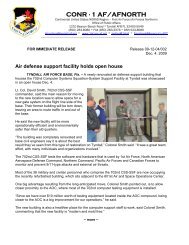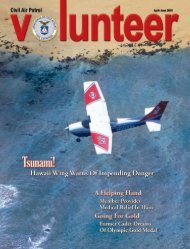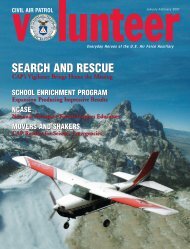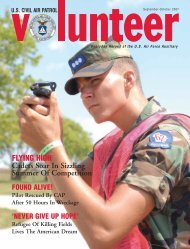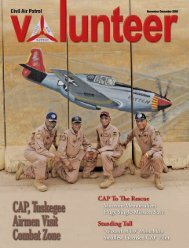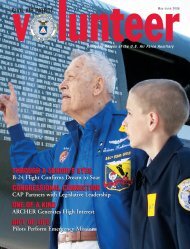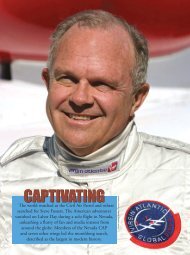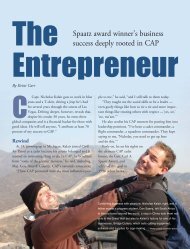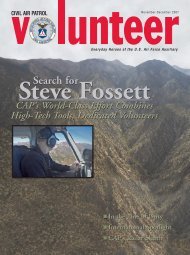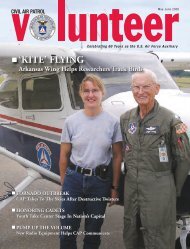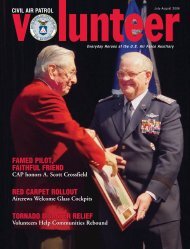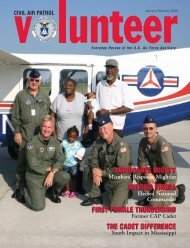CAPITAL CLOSE-UP
Hi-res - CAP VolunteerNow
Hi-res - CAP VolunteerNow
- No tags were found...
Create successful ePaper yourself
Turn your PDF publications into a flip-book with our unique Google optimized e-Paper software.
IIt was 1948 and the war was over. Young GIs<br />
returned to their hometown of Plainville, Conn.,<br />
with a renewed zest for life. With very little<br />
money but plenty of time, many found their purpose<br />
at an airport created by a local pilot, Stan<br />
Robertson.<br />
Robertson, 98, an innovative and comical man,<br />
announced in the mid-1940s he was going to build the<br />
airport. Little did he know his airport would become the<br />
runway where hundreds of youths would launch their<br />
careers in aviation.<br />
From the moment Robertson saw his first aircraft in<br />
1911 (ironically, one that crashed into a tree), he was<br />
hooked. He flew as often as possible, even purchasing<br />
his own plane, which he parked in the backyard of his<br />
family’s farm. Today, Robertson has logged more than<br />
10,000 hours of flight time and he continues to ride<br />
along whenever possible.<br />
In the military, Robertson flew with an elite intermediate<br />
squadron, the Air National Guard's 1st Air<br />
Commandos, from Bradley Field in Hartford,<br />
Conn. A decorated hero, he saved more than 200<br />
British lives flying over the “Burma Hump” in the<br />
Himalayas in a small L-1 aircraft.<br />
Upon his return to Connecticut, Robertson<br />
needed a good place to store his personal aircraft.<br />
Landing in small clearings and cow fields was tiresome<br />
and dangerous. So, the idea for the airport<br />
was born. Robertson recruited several local young<br />
veterans to help with the venture, including Maj.<br />
Alfred J. Mastrianni, who would later become the<br />
second commander of CAP’s Plainville Cadet<br />
Squadron, now known as the Charles K. Hamilton<br />
Composite Squadron.<br />
Initially, Robertson Field, named for its founder,<br />
consisted of a grass runway, a small 5-by-7-foot<br />
converted chicken coop shack and an outhouse.<br />
Though the accommodations were modest, the<br />
townspeople were thrilled. The newly formed CAP<br />
squadron asked to store its plane and to hold meetings<br />
at Robertson Field. Robertson readily agreed and<br />
even helped teach the cadets how to fly.<br />
The airport became the local hangout for the 30-plus<br />
cadets in Plainville. “We lived at the airport,” said former<br />
cadet and retired airline pilot Paul Cellecz. “We<br />
would peddle our bikes over there after school and camp<br />
out at the shack. We all loved flying and just wanted to<br />
be there at the airport.”<br />
The squadron grew quickly, thanks to Robertson's<br />
generosity and the encouragement of the people of<br />
Plainville. The facility also nurtured numerous careers.<br />
Over the past 54 years, hundreds of aviation careers,<br />
many experienced by pilots taught by Robertson himself,<br />
were inspired at the airstrip.<br />
Former commander Alfred Mastrianni remembers<br />
many of the cadets who have gone on to become successful<br />
professionals, military officers, professors and<br />
commercial and private pilots. “This sleepy little town<br />
has deep roots in aviation. People gave their time,<br />
money and resources to encourage and train the sharp<br />
Squadron Trivia<br />
In the first years, the Plainville squadron<br />
was made up of World War II vets who<br />
came back from the war and could not find<br />
a job. It was a very difficult economic time.<br />
There were ex-pilots, pilot instructors,<br />
paranurses (nurses who were parachutists), a<br />
full-time physician, a lawyer and a full Air<br />
Force colonel who became an adviser to the<br />
Civil Air Patrol. They hung out at the<br />
airport and, actually, managed it full time.<br />
Back then, if you served 15 years in the<br />
military, you could complete 20 years of<br />
service after the war by serving in CAP.<br />
Civil Air Patrol Volunteer 45 May-June 2007



